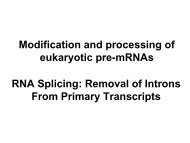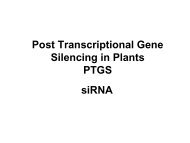Create successful ePaper yourself
Turn your PDF publications into a flip-book with our unique Google optimized e-Paper software.
At the 2007 annual meeting in Ile de Bendor and an extended meeting at the Marseille airport, WP13 membersmet and unanimously agreed that what the field of co-transcriptional splicing needs is the ability to apply themany new in vivo techniques for examining the relationship between transcription and splicing (e.g. in vivoelongation assays, ChIP, chromatin modifications, etc) to novel and physiologically relevant systems. Therefore,we propose we would benefit as a group by committing ourselves to the deliverables described in the new JPAfor WP13 month 25-42.Work Package 14: Chemical Biology and TherapeuticsAfter 24 months many of the initial objectives of this workpackage have been achieved. <strong>EURASNET</strong> membershave collectively obtained hundred’s of small chemical molecules that interfere with constitutive or alternativepre-mRNA splicing and they have optimized strategies for using antisens oligonucleotide to modulatealternative splicing. Several groups have obtained active molecules to be tested in animal models.Constitutive splicing inhibitors: Plan Months 25-42Fifteen compounds have been shown to inhibit splicing in vitro at different stages of spliceosome assembly(Partner 1a and 22) and therefore were used to establish the composition of stalled spliceosome.The aim for the future 18 month will be to identify direct molecular targets of these substances. First, wewill test derivatives of these substances regarding their effect on pre-mRNA splicing in vitro. Synthesis of thesederivatives will be performed by the research unit “Conception, Synthesis and Vectorisation of Biomolecules”at the Institut Curie (David Grierson, Paris/France) and/or by the “Scottish Hit Discovery Facility” at theUniversity of Dundee (Julie Frearson, Dundee, Scotland). <strong>EURASNET</strong> acquired synthesis and support for these(and similar) purposes at both facilities. These analyses will identify the functional group(s) and overall scaffoldrequired for inhibition by the substances. Comparison of these results within these chemicals, with otherrecently identified inhibitors of pre-mRNA splicing (partner 12a), and with well-characterized inhibitors ofenzymatic activities as they are present in the spliceosome (e.g. kinases or phosphatases) will give indicationshow these substances inhibit pre-mRNA splicing in vitro. Second, we will try to identify the molecular targetsof these inhibitors. For this, appropriately modified versions of the inhibitors will be attached to a column, andproteins that bind to these chemicals will be identified by affinity-chromatography followed by massspectrometry.Alternatively, an activatable crosslinker can be covalently attached to the inhibitors. Afterincubation with partially purified spliceosomes or total nuclear extract, crosslinking of the chemicals will beinitiated and the modified proteins identified by mass-spectrometry. This will identify candidate factors, whichwill be analysed further. Both approaches require derivatives of the original inhibitors. The design of these willbe helped by the analysis of inhibitor-derivatives as described above. Again, synthesis will be performed at theInstitut Curie and/or the University of Dundee. The mass-spectrometry will be performed in collaboration withHenning Urlaub (partner 1c), who has longstanding experience in protein-protein and protein-RNA crosslinkinganalysis by mass-spectrometry.Specific inhibitors of ESE-dependent splicing (indole derivatives): Plan Months 25-42Identification of 100 indole derivatives that selectively inhibit the activity of individual SR proteins by Partner12a offered the exciting possibility to develop an alternative pharmacological approach for AIDS, aging, DMDand cancer treatment, based entirely on the use of “small molecules inhibitors “ to modulate splicing efficienciesof target pre-mRNAs. The broad objectives of this proposal are to design, synthesize and screen analogues ofthe initial molecule for maximum activity and minimum cytotoxic activity, to elucidate the interaction betweenselected analogues and SR proteins. The strategy has focused on developing drug like molecules disrupting thefused polyaromatic ring system of IDC16 (an SF2/ASF inhibitor) and generating a series of 200 ring openedanalogues. We are currently testing whether newly synthesized molecules will maintain some of the putativeessential structural features. It is anticipated that screening of libraries of analogues will result in identificationof active compounds for lead optimization and for use in studies to elucidate the mechanism of SF2/ASF proteininhibition.219







